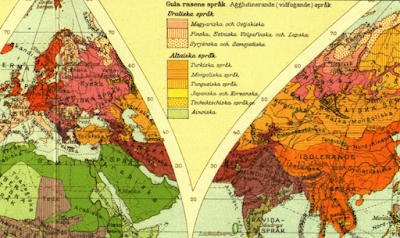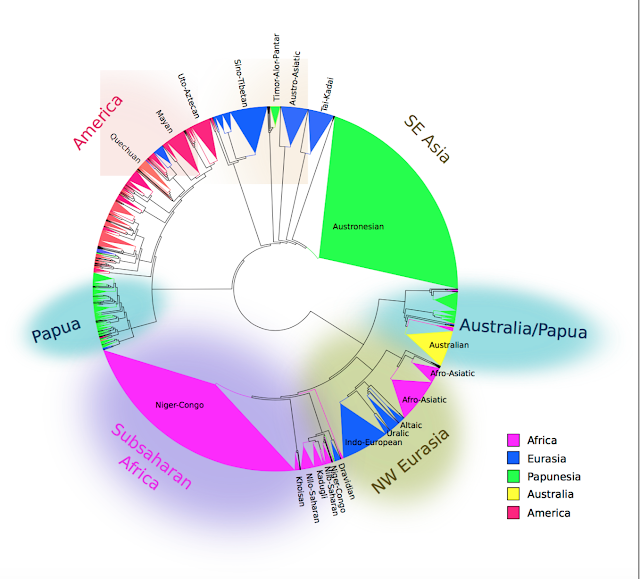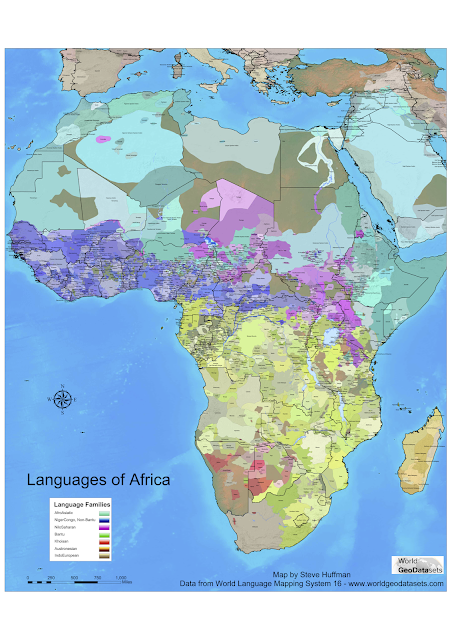A racist map of the world's languages
 |
| Detail of world map of languages and races from 1924. The legend outlines language groups of the "yellow race". |
In order to move forward towards racial and social justice as a discipline we must become familiar with our history and the ways in which racist, colonialist, sexist and classist ideas are still present in our academic spaces. I would like to present to you a concrete piece of evidence of our racist past in particular - a world-map where languages are grouped into three races: white, yellow and black.
Charity Hudley, Mallinson and Bucholtz outlines several steps which they believe linguistics as a disciple need to take in order to advance towards racial justice. One of them is:
- Fully acknowledge the ongoing legacy of the field's history of racism and colonialism (Bolton & Hutton 2000, Errington 2001, Leonard 2018)
In the spirit of that, I'd like to talk about a Swedish map from 1924 depicting the languages of the world, coloured by language families and grouped into races.
This map is part of a set of maps which was made by the Swede Docenten Friherren Sten De Geer. De Geer was docent in geography, which is a higher academic degree than doctor. He specialised in economic geography and ethnographic/cultural geography. These maps were published in an atlas by Åhlen & Holm AB for the Swedish Red Cross. The atlas was made to educate the general public of Sweden and Scandinavia about the world's countries and people.
The map in question is found on the lower part of the image below. The image contains two maps, the upper one depicts religions and the lower languages. All languages of the world are grouped into linguistic groups (such as Germanic, Bantu or Malayic) and subsumed under a super-category of race. For example, Germanic languages are of the "white race", Bantu "black" and Malayic are of the "yellow race".
 ________________________________________
________________________________________Below is the text from the lower map of languages and races translated from Swedish to English by me. I've stayed as close to the original as possible, except in some cases where I use a more well-known English label for a category, for example "syrjänska" = "Komi".
________________________________________
Translation:
The white race's languages (Inflectional languages)
Germanic
Romance
- French, Spanish, Catalan, Italian and Romanian
- Portuguese
Slavic languages
Greek and Albanian languages
Iranian languages, together with Armenian and Caucasian
Hindu languages
Singalese (Hindi-Dravidian)
Latvian & Lituhanian
Celtic
Basque
Semitic languages
Hamitic languages
The yellow race's languages (Agglutinating languages)
Uralic languages
- Hungarian and Eastern Khanty
- Finnish, Estonian, Volga-Finnish and Sami
- Komi and Samoyedic
Altaic languages
- Turkic languages
- Mongolian languages
- Tungusic languages
- Japanese and Korean
- Chukchi languages
- Aino
Dravidian languages (spoken by negroid people)
Munda languages (spoken by negroid people)
Incorporation languages
- Indian languages
- Eskimo and Aleut
Stem-isolating languages
- Malay languages (including Polynesian)
Isolating languages
- Isolating
The black race's languages (prefixing languages)
Bantu (spoken by negroid people)
Other negroid languages
- Sudanese languages
- Hottentott and Bushman languages
- Papuan
- West-Papuan (Negrito language)
- Australnegro languages
________________________________________
There is a lot to say here, and I am sure I will not be able to cover it all. I do not have the accompanying information about the construction or design of the map (if it exists).
Let us start by making a few specific observations:
- Just so it is said: as far as I am aware, historical linguists at this time (1924) did not propose that they had linguistic evidence of the three race groups as meaningful linguistic units. If they did propose such a thing, it must have been with skin colour as the sole evidence - not the comparative method and vocabulary.
- The division of three races that the map makes, "white", "yellow" and "black", is probably influenced by the religious and racist researcher Georges Cuvier. He proposed that humans should be divided into three races, the Caucasian (white), Mongolian (yellow), and the Ethiopian (black). From wikipedia: Cuvier claimed that Adam and Eve were Caucasian, the original race of mankind. The other two races originated by survivors escaping in different directions after a major catastrophe hit the earth 5,000 years ago, with those survivors then living in complete isolation from each other. Cuvier categorized these divisions he identified into races according to his perception of the beauty or ugliness of their skulls and the quality of their civilizations.
Just.. sit with that for a while before we go on. Read it one more time.
- The creator of the map is himself struggling with the exclusive division of the languages into the three races, placing Dravidian and Munda languages under "yellow", but noting that they are spoken by "negroid people". I don't know what to make of that really, but it is noticeable.
- The level of granularity alone betrays a racist attitude. There is much more detail to the various sub-groupings of Indo-European languages, while the rest of the world is represented in far, far less detail. For example, most East Asian languages are included under the label "Isolating". "Isolating" is a description of the grammar of a language, not a genealogical group. Even though our understanding of the relationship between East Asian languages was not as advanced in 1924 as it is now, the category "Tibeto-Burman" did in fact exist. The map was made for a Scandinavian audience which may mean they expected finer detail closer to home, but even so the coarseness of categorisation outside of Europe is extreme. The lack of attention betrays a lack of care.
- Indigenous languages of Americas and Australia are lumped together into two respective groups even though they each consist of very large amounts of different languages families. For example, the category labelled "Indian" on the map encompasses 1,000+ languages of 160+ families. Contrast this with Europe and our 230-ish languages where we're even getting distinctions of lower genealogical subgroups. To call "Indian" a shit category is the understatement of the century, especially considering the level of detail in other areas. Perhaps you think they just didn't know better? The "grandfather of modern anthropology" Franz Boas published his first volume of the Handbook American Indian Languages in 1911 where he, among other things, described the diversity of the Americas and lists 55 families north of Mexico. So, knowledge and information existed. If in 1924 you were to get the assignment to make a map of the world's languages and you specialised in ethnography, information existed which could be used. (You can read the introduction of that book here. It's a worthwhile read, Boas discusses race at great length.) Again, lack of attention shows a lack of care from the creator.
- The depiction of the distribution of indigenous languages of the Americas, Australia and Aotearoa (New Zealand). I take it that the intention of the mapmaker was to only show the most common language in a given place and that this is why most of these regions are depicted only with the colonial European languages, with pockets of "Indian languages" in the Americas, "Australnegro" languages in Australia and a small section of "Malay" languages in Aotearoa. These red and pinkish places which appear entirely conquered by European colonisers were in many cases multilingual. These are places where indigenous languages were spoken and are still spoken today. To make the choice to not depict these languages at all.. it is a choice that perpetuates the erasure of indigenous people.
Okay. I think I'll stop there for now lest my blood pressure gets too high. Feel free to leave more observations of this map in the comment section.
I think that there is a common misconception that racism was essentially something unique to Germany in the 1930's. Depictions of non-german Europe during the second world war often seems to entirely erase the racism we know was there (and still is). For science in particular, there is a great tendency to ignore the racist legacy of our disciplines and to fail to address its continuation and the impact it has on scholars and research today.
I am a Swedish white woman, I grew up in the university town of Uppsala. Uppsala was the Swedish centre of research into "race-biology" from 1922-1958. This involved the measurement of skulls and the production of research which aimed at providing the state with scientific justifications for "exact racial hygiene" and "rational population policy". I didn't know exactly what this entailed until I became an adult, but growing up I did know the location of "rasbiologiska institutet" - it's a local landmark and reference point still.
The welfare state of Sweden in the 50's and 60's was racist and supported by scientists. Antiziganism was particularly strong. In Scandinavia there is a group of Romani people commonly known as 'travellers'. They have lived there for over 500 years. We sterilised these people, and people which were deemed "slow of the mind" or otherwise genetically undesirable without their consent. This was explicitly done for the sake of "eugenic hygiene". This was legal and encouraged between 1934-1975. Approximately a total of 63,000 people were sterilised without consent. The peak was in 1947-48, i.e. after the war had ended.
The Swedish nation state has also abused the indigenous people of the land - the Sami. This involved among other things taking children from their families, hurting them physically and emotionally - robbing them of their past and ruining their future.
I can highly recommend watching the movie "Sami blood" which depicts this abuse. It features a particular scene, linked below, where the the northern regional school of Sami children get a visit from intellectual men from down south, from Uppsala. As the event was announced to the children, I distinctly remember thinking "oh fun that's where I from!" before half a second later it hit me: there is only one reason Uppsala men are visiting a school like this in the 1930's. They are there to measure these children, to collect data on their racial inferiority and justify their continued mistreatment.
Scene from the movie Sami Blood where the main character, Elle-Marja, is examined
and measured by visitors from the race-biology research centre in Uppsala.
There is another scene, which is perhaps even more relevant to us as linguists, where Elle-Marja meets a group of "well-meaning" white anthropology students in Uppsala. They pressure her to preform jojk, a Sami style of singing. It becomes clear that to them she is an ethnological curiosity - not a fellow teenager.
Abusive treatment of "undesirables", ethnic minorities and indigenous people is by no means unique to Sweden, but I believe many Swedes and people outside of Sweden know little of this. These events are not isolated, old or forgotten - they are recent and reverberates through to today. Forced sterilisation due to eugenic reasons were preformed in Sweden all the way into the 1960's and they were legal until 1975. The Canadian Indian Residential School system which abused ingenious children existed for over 150 years (1840's to 1996). The Australian government took indigenous children from their families from 1909 until 1969. The list goes on. Read more and let it all sink in. Learn whose land you live on and and the history of the place and the nation state there. These are stolen generations, this can never be undone. This is not old, this is recent. Let it become part of your world - because it already is. Wether you like it or not.
The map which prompted this post was published in 1924, a decade before the eugenic force sterilisation laws came into effect in Sweden. Extremely racist ideas were included in educational material for the general public without question. It was obvious, this is the way things are and this is what we should tell our children. There are three races, and here are their languages.
No only are these events more recent than you may like to think, racism is still around - also in academia. For this post, I focussed on events decades past but which have consequences for modern science as well. We are still a discipline which neglects languages and people outside of Europe, both as fellow scholars and as topics worthy of honest and respectful research. If you haven't already, go read the paper by Charity Hudley, Mallinsson and Bucholtz in Language and the following responses to learn more about race in linguistics as a discipline today.




«Granularity»
ReplyDeleteJust some immediate thoughts; a few more-recent maps came to my mind (that has nothing to do with racism):
1. The National Geographic's Voices of the World map (1999). I had this map on the wall when I was living with my parents. It amazed me how a language map by a US organisation that has done so much for indigenous America, can have a language map with a separate colour/text for Hmong-Mien (which is good), but just a single colour/text for each of North, Meso, and South America. Old-World bias I suppose.
2. The subgrouping within Yue Chinese in, e.g. the 1st (1987/1989) and 2nd (2012) editions of the Language Atlas of China. The classification schemes here and elsewhere are way more reasonable/detailed for the Yue dialects in Guangdong, especially around the Pearl River Delta, than in Guangxi. One problem is that most scholars are from Guangdong, the Pearl River Delta in particular (≈ Cantonese speakers). Another problem is that, even though the availability of data of the Yue dialects in Guangxi and western Guangdong was already not so bad by 2012, people used very outdated methods when classifying speech varieties.
With the lumping of the "isolating languages" in the 1924 De Geer map, I suppose it was indeed part of the racism package. More directly, I suppose it was the belief that the morphologically "isolating" languages were degenerate in comparison with the "fusional" languages. I have done fieldwork on both morphologically complex and morphologically isolating languages. Even now, sometimes I get dismissive looks for working on morphologically isolating languages from, e.g., some European linguists. Many of them are blind to the high level of complexity that lies with the morphologically isolating languages. (Sometimes there are racism problems too; rather than arguing with them, I usually go around and educate their students instead, if they are nice.)